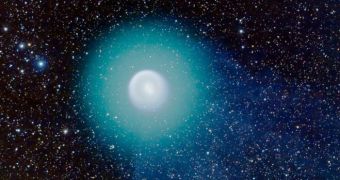Astronomers analyzing the behavior the comet 17P/Holmes exhibited during its last three visits to the inner solar system say that we might see the celestial body blow up in 2014, when it heads towards the Sun for another pass.
The object revealed a mysterious and amazing flare three times before, while flying by the Sun. Experts apparently believe that the event is a warning sign of an impending explosion that could be fueled by the large amounts of carbon monoxide gas the object contains.
This particular comet captured the attention of astronomers back in 2007, when it was shaken by a massive explosion that saw it swelling to a diameter that briefly exceeded the Sun's.
As this happened, the space body experienced a surge in brightness, becoming 500,000 times more luminous. In just a few moments, it passed from being a humble spec of dust in telescope images to being visible from Earth with the naked eye.
During these events, the comet emitted an estimated 100 million tons of dust and ice particles into space, about the equivalent of all the ash released by Mount St. Helens during its largest eruption.
All this ruckus naturally prompted countless hours of observations, carried out from around the world with literally hundreds of telescopes and observatories. Despite this interest, no clear cause for the massive explosion was ever established.
At first, experts believed that accumulations of amorphous water-ice may have been trapped under a dust shield. As the comet approached the Sun, they proposed, the water-ice sublimated, and expanded in a massive explosion, that projected 17P/Holmes' crust outwards.
But Polish researchers now demonstrate that this was not the case, proving that water-ice crystallizing could not provide sufficient energy to account for the magnitude of the blast, Wired reports.
The investigators say that the comet was most likely fueled by carbon monoxide gas, and that this is the chemical that allowed for the explosion to take place at such a scale. Details of the work will appear in an upcoming issue of the esteemed scientific journal Icarus.
The paper was authored by geophysicists Konrad Kossacki, from the Warsaw University and Slawomira Szutowicz, from the Polish Academy of Sciences. They say that additional studies of the comet, based on the new data, could reveal its chances of blowing up in 2014.
This is the next time when the object is scheduled to make its way in the inner solar system. As it will approach the Sun for another pass, the carbon monoxide gas it contains will expand again, potentially destroying the comet as a whole.

 14 DAY TRIAL //
14 DAY TRIAL //